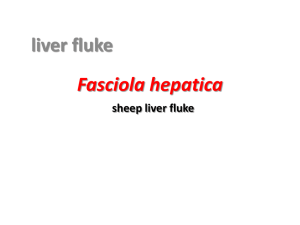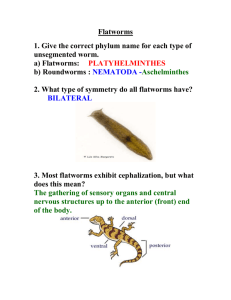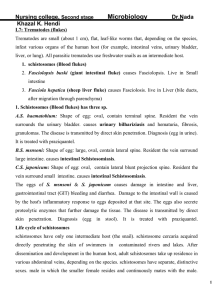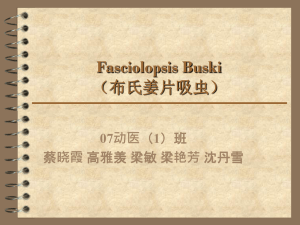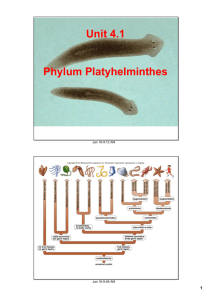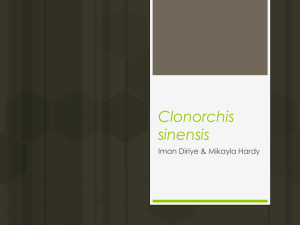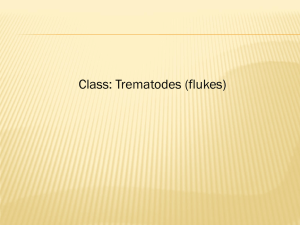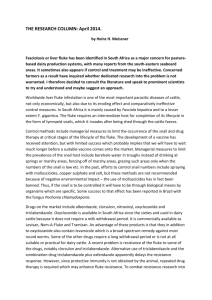intestinal fluke
advertisement
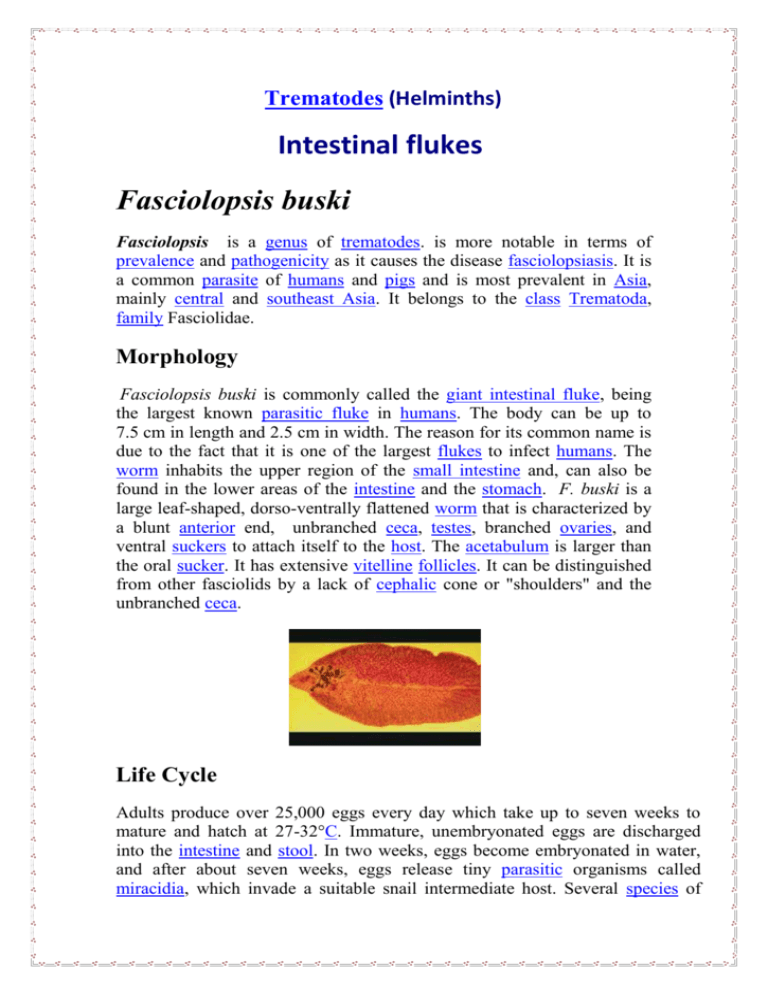
Trematodes (Helminths) Intestinal flukes Fasciolopsis buski Fasciolopsis is a genus of trematodes. is more notable in terms of prevalence and pathogenicity as it causes the disease fasciolopsiasis. It is a common parasite of humans and pigs and is most prevalent in Asia, mainly central and southeast Asia. It belongs to the class Trematoda, family Fasciolidae. Morphology Fasciolopsis buski is commonly called the giant intestinal fluke, being the largest known parasitic fluke in humans. The body can be up to 7.5 cm in length and 2.5 cm in width. The reason for its common name is due to the fact that it is one of the largest flukes to infect humans. The worm inhabits the upper region of the small intestine and, can also be found in the lower areas of the intestine and the stomach. F. buski is a large leaf-shaped, dorso-ventrally flattened worm that is characterized by a blunt anterior end, unbranched ceca, testes, branched ovaries, and ventral suckers to attach itself to the host. The acetabulum is larger than the oral sucker. It has extensive vitelline follicles. It can be distinguished from other fasciolids by a lack of cephalic cone or "shoulders" and the unbranched ceca. Life Cycle Adults produce over 25,000 eggs every day which take up to seven weeks to mature and hatch at 27-32°C. Immature, unembryonated eggs are discharged into the intestine and stool. In two weeks, eggs become embryonated in water, and after about seven weeks, eggs release tiny parasitic organisms called miracidia, which invade a suitable snail intermediate host. Several species of genera Segmentina and Hippeutis serve as intermediate hosts. In the snail the parasite undergoes several developmental stages (sporocysts, rediae, and cercariae). The cercariae are released from the snail and encyst as metacercariae on aquatic plants such as water chestnut, water caltrop, and other plants. The final host, becomes infected by ingesting metacercariae on the aquatic plants. After ingestion, the metacercariae excyst in the duodenum in about three months and attach to the intestinal wall. There they develop into adult flukes (20 to 75 mm by 8 to 20 mm) in approximately 3 months, attached to the intestinal wall of the mammalian hosts (humans and pigs). The adults have a life span of about one year. Pathogenesis Infection known as fasciolopsiasis . and the damage which live attached th the mucosa of duodenum may be traumatic, obstructive, and toxic . at the site of attachment the worm cause inflammation and ulceration of the mucosa. Large number of worms provoke increased secretions of mucus and may lead to partial obstruction of the bowel. In massive infections patient develops profound intoxication and sensitization that result from absorption of the worms metabolites into the system. Occasionally vitamin B12 absorption is impaired . Symptoms Most infections are light and asymptomatic. In heavy infections, symptoms can include abdominal pain, chronic diarrhea, anemia, allergic responses, sensitization caused by the absorption of the worms allergenic metabolites (may eventually cause death of patient), and intestinal obstruction. Laboratory Diagnosis Microscopic identification of eggs, or more rarely of the adult flukes, in the stool or vomitus is the basis of specific diagnosis. The eggs are indistinguishable from those of Fasciola hepatica. Fasciolopsis buski egg Treatment Praziquantel is the drug of choice for treatment. Treatment is effective in early or light infections. Heavy infections are more difficult to treat. Studies of the effectiveness of various drugs for treatment of children with F. buski have shown tetrachloroethylene as capable of reducing faecal egg counts by up to 99%. Other antihelmintics that can be used include mebendazole, and nitroxynil are also highly effective. ----------------------------------- Heterophyes heterophyes Morphology small flukes found in the small intestines of fish-eating birds and mammals. The adult flukes range from 1.0mm to 1.7mm long and about 0.35mm at their greatest width. The body of the fluke is covered in scales mostly concentrated at the anterior end. Also at the anterior end is an oral sucker. Located in the medioanterior of the body is the acetabulum. At the posterior end of the fluke are two oval testes. The vas deferens leading from the testes expands to form a seminal vesicle. The fluke also has female reproductive organs. the fluke's has one ovary and leading away from the ovary is the vitellaria. The uterus is a long tube like structure that also leads away from the ovary. The genital pore which is lined with 60-90 toothed spines. The genital pore is where the fluke releases its eggs. Life cycle The adult flukes live burrowed between the villi of the host's small intestine. The eggs that are laid contain a miracidium but do not hatch until they are ingested by a snail (Pirenella conica in Egypt or Cerithidia cingula in Japan). Inside the snails gut, the miracidium becomes a sporocyst which then begin to produce rediae. The rediae produce cercariae which then exit the snail, swim toward the surface of the water, and slowly fall back down. On their way down, they contact a fish and penetrate into the epithelium of the fish. Here, the cercariae encyst in the muscle tissue. The definitive host, such as humans or birds, eats the undercooked or raw meat of a fish and ingest the parasite. Pathogenesis Each worm causes a mild inflammatory reaction at its site of contact with the intestine. In heavy infections which are common cause damage to the mucosa and produce intestinal pain and mucous diarrhea. Sometimes eggs can enter the blood and lymph vascular systems through mucosa go into the ectopic sites in the body. The heart can be affected with tissue reaction in the valves and myocardium that cause heart failure. Eggs can also get into the brain or spinal cord and cause neurological disorders and sometimes fatalities. Diagnosis Diagnosis done by stool examination is difficult when adult worms are not present because the eggs are hard to distinguish from C.sinensis. Treatment Praziquantel, a quinolone derivative.

